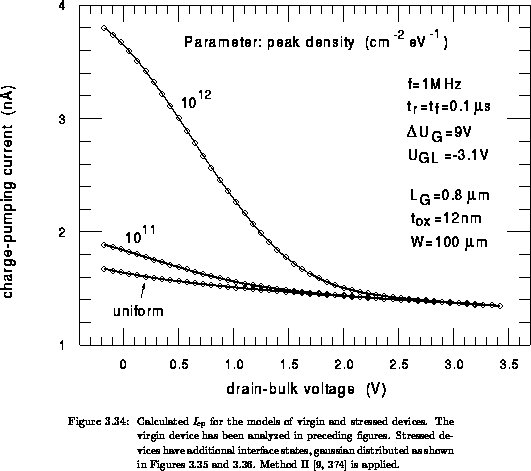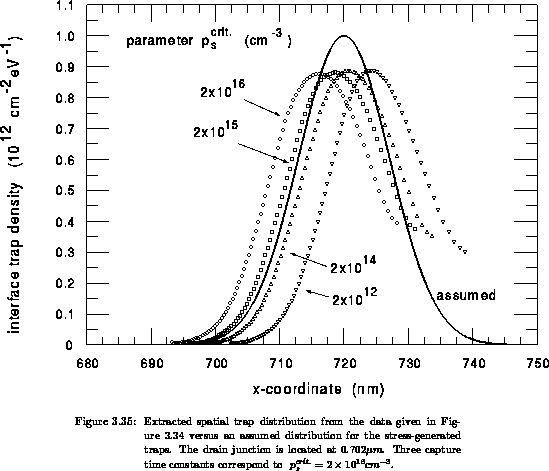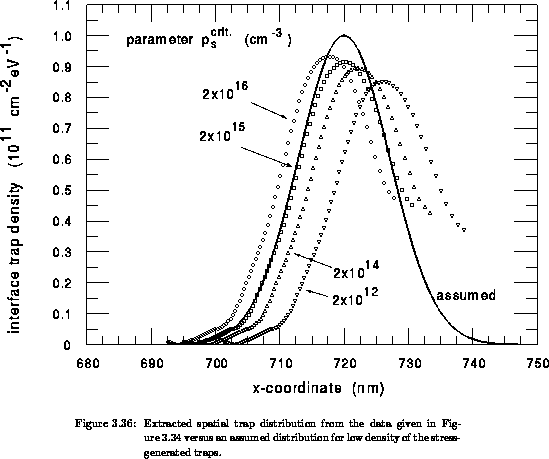Non-symmetrical Case:




Next: Other Large-Signal Charge-Pumping
Up: 3.5.2 Extraction of the
Previous: Symmetrical Case:
Stressed devices represent a non-symmetrical case.
Figure 3.34 shows the calculated  curve for the virgin device with a uniform trap distribution of
density
curve for the virgin device with a uniform trap distribution of
density  , shown in
Figure 3.32 and for two stressed devices. The damage
in the stressed devices is modeled by superposed gaussian distributed
traps with peak densities of
, shown in
Figure 3.32 and for two stressed devices. The damage
in the stressed devices is modeled by superposed gaussian distributed
traps with peak densities of  and
and  as shown
in Figures 3.35 and 3.36.
The traps reside within the drain junction, whereas the location of the
trap peak is chosen relative to the electric-field peak and the electron
and hole currents injected into the oxide at the stress bias
as shown
in Figures 3.35 and 3.36.
The traps reside within the drain junction, whereas the location of the
trap peak is chosen relative to the electric-field peak and the electron
and hole currents injected into the oxide at the stress bias
 as explained in Appendix D.
Applying the extraction
procedure on the difference
as explained in Appendix D.
Applying the extraction
procedure on the difference  between the currents in the stressed device
between the currents in the stressed device  and the virgin device
and the virgin device
 , instead of on
, instead of on  directly, leads to a significant reduction
of the undesired contribution of the term due to the variable
directly, leads to a significant reduction
of the undesired contribution of the term due to the variable  in the channel; relationship G.13 in Appendix G. For
the traps localized in a narrow interval, the change of
in the channel; relationship G.13 in Appendix G. For
the traps localized in a narrow interval, the change of  with
with  is
primarily caused by the change of
is
primarily caused by the change of  , while the variation of
, while the variation of  for
the traps which contribute to the charge-pumping current is a second order
effect. The distributions recalculated from the curves shown in
Figure 3.34 are given in Figures 3.35
and 3.36. Contrary to the claim in the
literature [398][9] that the value of the parameter
for
the traps which contribute to the charge-pumping current is a second order
effect. The distributions recalculated from the curves shown in
Figure 3.34 are given in Figures 3.35
and 3.36. Contrary to the claim in the
literature [398][9] that the value of the parameter  is not critical, this parameter ought to be chosen carefully; it determines
the location of the extracted peak. The exact location of the peak of the
stress-induced traps relative to the peak of the electric field can be important
while discussing the injection and trap-generation mechanisms ([9]).
We found that the value of
is not critical, this parameter ought to be chosen carefully; it determines
the location of the extracted peak. The exact location of the peak of the
stress-induced traps relative to the peak of the electric field can be important
while discussing the injection and trap-generation mechanisms ([9]).
We found that the value of  which corresponds to the three
hole-capture time constants during the gate pulse base level
which corresponds to the three
hole-capture time constants during the gate pulse base level  leads
to a shift to the left from the assumed distribution. For
Figures 3.35 and 3.36 the
corresponding
leads
to a shift to the left from the assumed distribution. For
Figures 3.35 and 3.36 the
corresponding  is
is  . This shift is
partially due to a finite width of the transition between the active and the
inactive charge-pumping areas. The transition region is not a step-like
function, but has a finite width of about
. This shift is
partially due to a finite width of the transition between the active and the
inactive charge-pumping areas. The transition region is not a step-like
function, but has a finite width of about  in the analyzed example.
The actual spatial shift in the extracted trap distributions is approximately
half of the width of the transition region. The factor
in the analyzed example.
The actual spatial shift in the extracted trap distributions is approximately
half of the width of the transition region. The factor  in
expressions 3.128 and 3.129 corresponds
approximately to the middle of the transition regions. The small discrepancy
in the amplitude observed in Figures 3.35
and 3.36 stems from longer emission times
in
expressions 3.128 and 3.129 corresponds
approximately to the middle of the transition regions. The small discrepancy
in the amplitude observed in Figures 3.35
and 3.36 stems from longer emission times  associated with the localized traps in the junction than with the traps in the
channel, which are used to obtain
associated with the localized traps in the junction than with the traps in the
channel, which are used to obtain  from
from  (see Figure 3.30).
(see Figure 3.30).

In conclusion, our study has confirmed the ability to accurately extract the
spatial trap distributions by using the discussed charge-pumping
method II when a proper  is assumed and
is assumed and  effect is
taken into account.
effect is
taken into account.






Next: Other Large-Signal Charge-Pumping
Up: 3.5.2 Extraction of the
Previous: Symmetrical Case:
Martin Stiftinger
Sat Oct 15 22:05:10 MET 1994
 curve for the virgin device with a uniform trap distribution of
density
curve for the virgin device with a uniform trap distribution of
density  , shown in
Figure 3.32 and for two stressed devices. The damage
in the stressed devices is modeled by superposed gaussian distributed
traps with peak densities of
, shown in
Figure 3.32 and for two stressed devices. The damage
in the stressed devices is modeled by superposed gaussian distributed
traps with peak densities of  and
and  as shown
in Figures 3.35 and 3.36.
The traps reside within the drain junction, whereas the location of the
trap peak is chosen relative to the electric-field peak and the electron
and hole currents injected into the oxide at the stress bias
as shown
in Figures 3.35 and 3.36.
The traps reside within the drain junction, whereas the location of the
trap peak is chosen relative to the electric-field peak and the electron
and hole currents injected into the oxide at the stress bias
 as explained in Appendix D.
Applying the extraction
procedure on the difference
as explained in Appendix D.
Applying the extraction
procedure on the difference  between the currents in the stressed device
between the currents in the stressed device  and the virgin device
and the virgin device
 , instead of on
, instead of on  directly, leads to a significant reduction
of the undesired contribution of the term due to the variable
directly, leads to a significant reduction
of the undesired contribution of the term due to the variable  in the channel; relationship G.13 in Appendix G. For
the traps localized in a narrow interval, the change of
in the channel; relationship G.13 in Appendix G. For
the traps localized in a narrow interval, the change of  with
with  is
primarily caused by the change of
is
primarily caused by the change of  , while the variation of
, while the variation of  for
the traps which contribute to the charge-pumping current is a second order
effect. The distributions recalculated from the curves shown in
Figure 3.34 are given in Figures 3.35
and 3.36. Contrary to the claim in the
literature [398][9] that the value of the parameter
for
the traps which contribute to the charge-pumping current is a second order
effect. The distributions recalculated from the curves shown in
Figure 3.34 are given in Figures 3.35
and 3.36. Contrary to the claim in the
literature [398][9] that the value of the parameter  is not critical, this parameter ought to be chosen carefully; it determines
the location of the extracted peak. The exact location of the peak of the
stress-induced traps relative to the peak of the electric field can be important
while discussing the injection and trap-generation mechanisms ([9]).
We found that the value of
is not critical, this parameter ought to be chosen carefully; it determines
the location of the extracted peak. The exact location of the peak of the
stress-induced traps relative to the peak of the electric field can be important
while discussing the injection and trap-generation mechanisms ([9]).
We found that the value of  which corresponds to the three
hole-capture time constants during the gate pulse base level
which corresponds to the three
hole-capture time constants during the gate pulse base level  leads
to a shift to the left from the assumed distribution. For
Figures 3.35 and 3.36 the
corresponding
leads
to a shift to the left from the assumed distribution. For
Figures 3.35 and 3.36 the
corresponding  is
is  . This shift is
partially due to a finite width of the transition between the active and the
inactive charge-pumping areas. The transition region is not a step-like
function, but has a finite width of about
. This shift is
partially due to a finite width of the transition between the active and the
inactive charge-pumping areas. The transition region is not a step-like
function, but has a finite width of about  in the analyzed example.
The actual spatial shift in the extracted trap distributions is approximately
half of the width of the transition region. The factor
in the analyzed example.
The actual spatial shift in the extracted trap distributions is approximately
half of the width of the transition region. The factor  in
expressions 3.128 and 3.129 corresponds
approximately to the middle of the transition regions. The small discrepancy
in the amplitude observed in Figures 3.35
and 3.36 stems from longer emission times
in
expressions 3.128 and 3.129 corresponds
approximately to the middle of the transition regions. The small discrepancy
in the amplitude observed in Figures 3.35
and 3.36 stems from longer emission times  associated with the localized traps in the junction than with the traps in the
channel, which are used to obtain
associated with the localized traps in the junction than with the traps in the
channel, which are used to obtain  from
from  (see Figure 3.30).
(see Figure 3.30).






